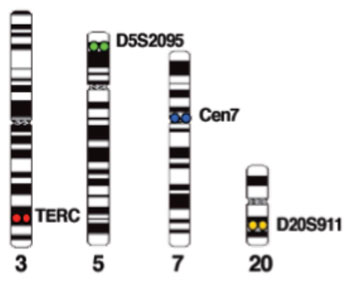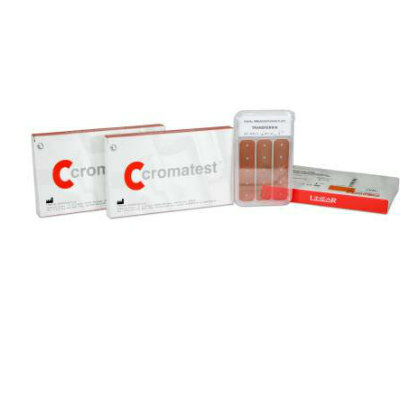Cervical Cancer Screening Test Receives Approval for the European Sector
|
By LabMedica International staff writers Posted on 09 Sep 2014 |

Image: Example of chromosomes stained with the FHACT combination probe: 3q26 (TERC) (red), 5p15 (D5S2095) (green), 20q13 (D20S911) (gold), and CEP7 (aqua) (Photo courtesy of Cancer Genetics Inc.).
A screening test that detects the clonal chromosomal aberrations (gains or amplifications) commonly found in cervical cancer specimens has received CE-marking that allows it to be distributed as a diagnostic test in the 28 countries making up the European Economic Area.
The Cancer Genetics Inc. (Rutherford, NJ, USA) FISH (fluorescence in situ hybridization)-based HPV-Associated Cancer Test (FHACT) utilizes the only four color FISH probe that can be used for cervical cancer screening as additional triage before referral for colposcopy.
The FISH analysis is performed on nuclei of cells derived from a liquid pap specimen using the FHACT combination probe manufactured by CGI Italia (Milan, Italy), a wholly owned subsidiary of Cancer Genetics Inc. The probe comprises 3q26 (TERC) (red), 5p15 (D5S2095) (green), 20q13 (D20S911) (gold), and CEP7 (aqua).
The FISH probe has been optimized to identify copy number gains of 3q26, 5p15, chromosome 7, and 20q13. In normal diploid interphase and metaphase cells, FHACT generates two red, two green, two blue, and two gold signals corresponding to the normal chromosomes 3, 5, 7 and 20 respectively. In cells with gain or amplification of 3q26, 5p15, 20q13 and/or chromosome 7, the number of red, green, gold, and/or blue signals will be greater than two each.
The FHACT test identifies irreversible genomic changes associated with progression to cancer. In addition to identifying those women most at risk for cervical disease, it can help reduce unnecessary, invasive testing and over-treatment in women who do not show the genomic abnormalities associated with disease progression.
"We are committed to the highest level of quality in the development and manufacture of our DNA-FISH probes and tests. Our probes are manufactured to meet or exceed all established quality and performance specifications, and comply with relevant safety and regulatory requirements in order to qualify them for CE marking," said Panna Sharma, CEO of Cancer Genetics, Inc. "Cervical cancer screening is evolving, but there remains a need for more definitive and genomically informed diagnosis. Our proprietary cervical cancer test, FHACT, was designed in response to this need. Having it affixed with the CE-mark will allow us to expand our marketing and sales in Europe, and allow for greater adoption of the test globally."
The FHACT method is protected by several US and international patents.
Related Links:
Cancer Genetics Inc.
CGI Italia
The Cancer Genetics Inc. (Rutherford, NJ, USA) FISH (fluorescence in situ hybridization)-based HPV-Associated Cancer Test (FHACT) utilizes the only four color FISH probe that can be used for cervical cancer screening as additional triage before referral for colposcopy.
The FISH analysis is performed on nuclei of cells derived from a liquid pap specimen using the FHACT combination probe manufactured by CGI Italia (Milan, Italy), a wholly owned subsidiary of Cancer Genetics Inc. The probe comprises 3q26 (TERC) (red), 5p15 (D5S2095) (green), 20q13 (D20S911) (gold), and CEP7 (aqua).
The FISH probe has been optimized to identify copy number gains of 3q26, 5p15, chromosome 7, and 20q13. In normal diploid interphase and metaphase cells, FHACT generates two red, two green, two blue, and two gold signals corresponding to the normal chromosomes 3, 5, 7 and 20 respectively. In cells with gain or amplification of 3q26, 5p15, 20q13 and/or chromosome 7, the number of red, green, gold, and/or blue signals will be greater than two each.
The FHACT test identifies irreversible genomic changes associated with progression to cancer. In addition to identifying those women most at risk for cervical disease, it can help reduce unnecessary, invasive testing and over-treatment in women who do not show the genomic abnormalities associated with disease progression.
"We are committed to the highest level of quality in the development and manufacture of our DNA-FISH probes and tests. Our probes are manufactured to meet or exceed all established quality and performance specifications, and comply with relevant safety and regulatory requirements in order to qualify them for CE marking," said Panna Sharma, CEO of Cancer Genetics, Inc. "Cervical cancer screening is evolving, but there remains a need for more definitive and genomically informed diagnosis. Our proprietary cervical cancer test, FHACT, was designed in response to this need. Having it affixed with the CE-mark will allow us to expand our marketing and sales in Europe, and allow for greater adoption of the test globally."
The FHACT method is protected by several US and international patents.
Related Links:
Cancer Genetics Inc.
CGI Italia
Latest Pathology News
- ADLM Updates Expert Guidance on Urine Drug Testing for Patients in Emergency Departments
- New Age-Based Blood Test Thresholds to Catch Ovarian Cancer Earlier
- Genetics and AI Improve Diagnosis of Aortic Stenosis
- AI Tool Simultaneously Identifies Genetic Mutations and Disease Type
- Rapid Low-Cost Tests Can Prevent Child Deaths from Contaminated Medicinal Syrups
- Tumor Signals in Saliva and Blood Enable Non-Invasive Monitoring of Head and Neck Cancer
- Common Health Issues Can Influence New Blood Tests for Alzheimer’s Disease
- Blood Test Formula Identifies Chronic Liver Disease Patients with Higher Cancer Risk
- Tunable Cell-Sorting Device Holds Potential for Multiple Biomedical Applications
- AI Tool Outperforms Doctors in Spotting Blood Cell Abnormalities
- AI Tool Rapidly Analyzes Complex Cancer Images for Personalized Treatment
- Diagnostic Technology Performs Rapid Biofluid Analysis Using Single Droplet
- Novel Technology Tracks Hidden Cancer Cells Faster
- AI Tool Improves Breast Cancer Detection
- AI Tool Predicts Treatment Success in Rectal Cancer Patients
- Blood Test and Sputum Analysis Predict Acute COPD Exacerbation
Channels
Clinical Chemistry
view channel
Blood Test Could Predict and Identify Early Relapses in Myeloma Patients
Multiple myeloma is an incurable cancer of the bone marrow, and while many patients now live for more than a decade after diagnosis, a significant proportion relapse much earlier with poor outcomes.... Read more
Compact Raman Imaging System Detects Subtle Tumor Signals
Accurate cancer diagnosis often depends on labor-intensive tissue staining and expert pathological review, which can delay results and limit access to rapid screening. These conventional methods also make... Read moreMolecular Diagnostics
view channel
At-Home Blood Tests Accurately Detect Key Alzheimer's Biomarkers
Diagnosing Alzheimer’s disease typically relies on brain scans or spinal fluid tests, which are invasive, costly, and difficult to access outside specialist clinics. These barriers have limited large-scale... Read more
Blood Test Combined with MRI Brain Scans Reveals Two Distinct Multiple Sclerosis Types
Multiple sclerosis (MS) affects more than 2.8 million people worldwide, yet predicting how the disease will progress in individual patients remains difficult. Current MS classifications are based on clinical... Read more
Ultra-Sensitive Blood Biomarkers Enable Population-Scale Insights into Alzheimer’s Pathology
Accurately estimating how many people carry Alzheimer’s disease pathology has long been a challenge, as traditional methods rely on small, clinic-based samples rather than the general population.... Read more
Blood Test Could Predict Death Risk in World’s Most Common Inherited Heart Disease
Hypertrophic cardiomyopathy (HCM) is the world’s most common inherited heart condition and affects millions of people globally. While some patients live with few or no symptoms, others develop heart failure,... Read moreHematology
view channel
MRD Tests Could Predict Survival in Leukemia Patients
Acute myeloid leukemia is an aggressive blood cancer that disrupts normal blood cell production and often relapses even after intensive treatment. Clinicians currently lack early, reliable markers to predict... Read more
Platelet Activity Blood Test in Middle Age Could Identify Early Alzheimer’s Risk
Early detection of Alzheimer’s disease remains one of the biggest unmet needs in neurology, particularly because the biological changes underlying the disorder begin decades before memory symptoms appear.... Read more
Microvesicles Measurement Could Detect Vascular Injury in Sickle Cell Disease Patients
Assessing disease severity in sickle cell disease (SCD) remains challenging, especially when trying to predict hemolysis, vascular injury, and risk of complications such as vaso-occlusive crises.... Read more
ADLM’s New Coagulation Testing Guidance to Improve Care for Patients on Blood Thinners
Direct oral anticoagulants (DOACs) are one of the most common types of blood thinners. Patients take them to prevent a host of complications that could arise from blood clotting, including stroke, deep... Read moreImmunology
view channel
Ultrasensitive Liquid Biopsy Demonstrates Efficacy in Predicting Immunotherapy Response
Immunotherapy has transformed cancer treatment, but only a small proportion of patients experience lasting benefit, with response rates often remaining between 10% and 20%. Clinicians currently lack reliable... Read more
Blood Test Could Identify Colon Cancer Patients to Benefit from NSAIDs
Colon cancer remains a major cause of cancer-related illness, with many patients facing relapse even after surgery and chemotherapy. Up to 40% of people with stage III disease experience recurrence, highlighting... Read moreMicrobiology
view channel
New UTI Diagnosis Method Delivers Antibiotic Resistance Results 24 Hours Earlier
Urinary tract infections affect around 152 million people every year, making them one of the most common bacterial infections worldwide. In routine medical practice, diagnosis often relies on rapid urine... Read more
Breakthroughs in Microbial Analysis to Enhance Disease Prediction
Microorganisms shape human health, ecosystems, and the planet’s climate, yet identifying them and understanding how they are related remains a major scientific challenge. Even with modern DNA sequencing,... Read moreTechnology
view channel
Pioneering Blood Test Detects Lung Cancer Using Infrared Imaging
Detecting cancer early and tracking how it responds to treatment remains a major challenge, particularly when cancer cells are present in extremely low numbers in the bloodstream. Circulating tumor cells... Read more
AI Predicts Colorectal Cancer Survival Using Clinical and Molecular Features
Colorectal cancer is one of the most common and deadly cancers worldwide, and accurately predicting patient survival remains a major clinical challenge. Traditional prognostic tools often rely on either... Read moreIndustry
view channel
BD and Penn Institute Collaborate to Advance Immunotherapy through Flow Cytometry
BD (Becton, Dickinson and Company, Franklin Lakes, NJ, USA) has entered into a strategic collaboration with the Institute for Immunology and Immune Health (I3H, Philadelphia, PA, USA) at the University... Read more


















